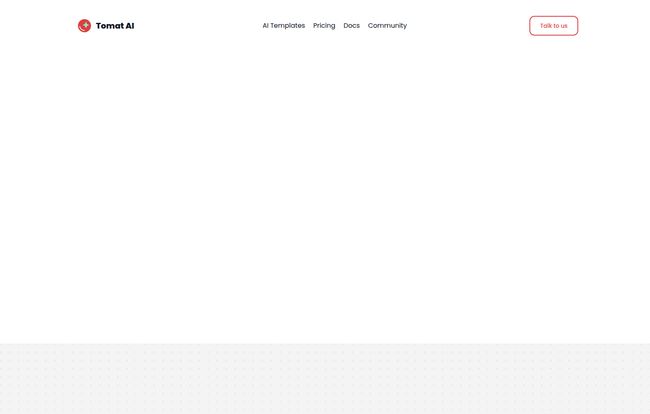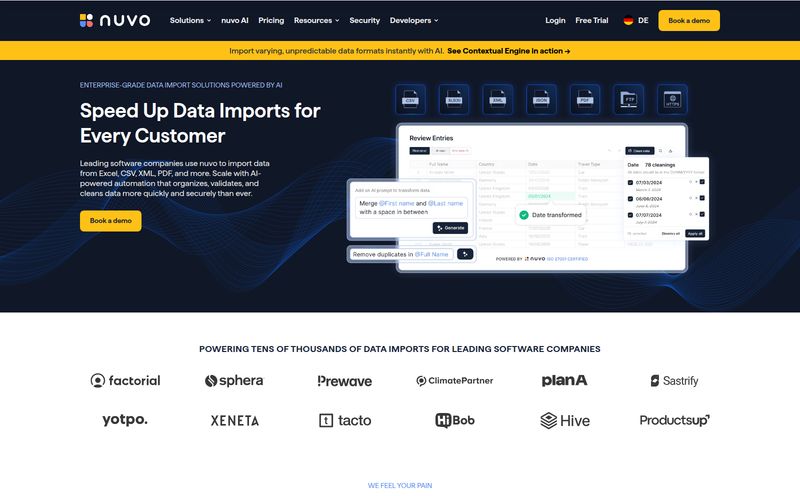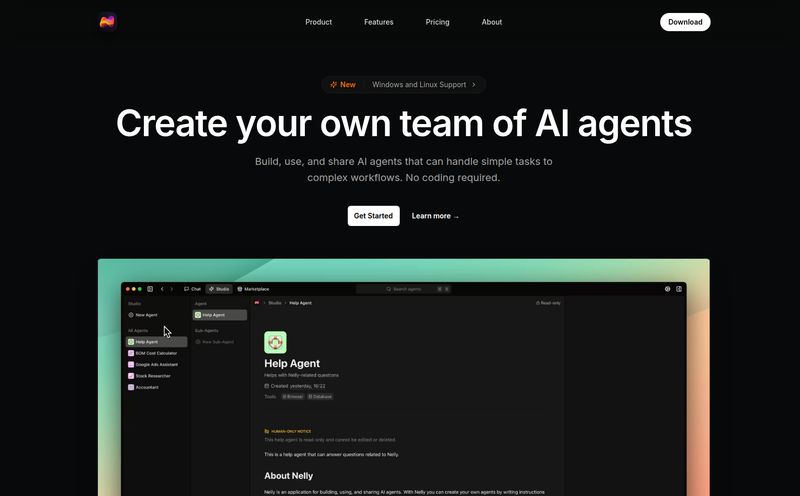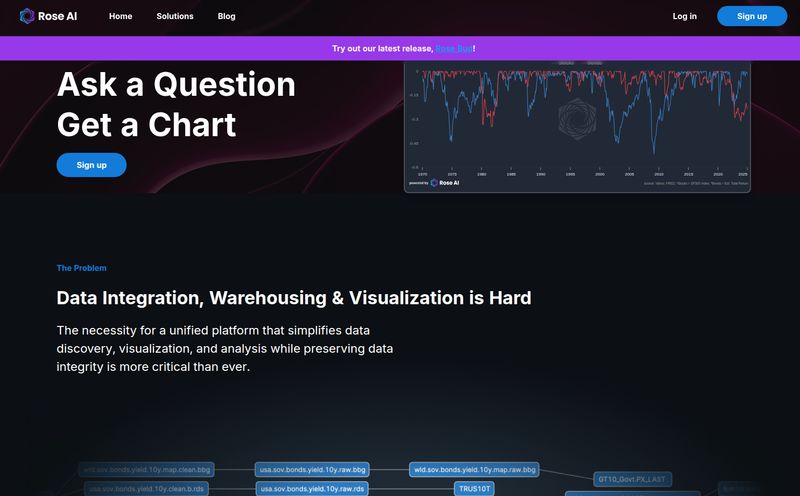If you’re in SEO, marketing, or running a small business, you live in spreadsheets. Google Analytics exports, SEMrush keyword lists, customer feedback forms, ad spend reports... it’s a deluge of CSVs and XLSX files. And cleaning that data? It’s the digital equivalent of trying to fold a fitted sheet. You know there’s a right way to do it, but you usually end up with a crumpled mess and a quiet sense of defeat.
I’ve spent more hours than I’d like to admit wrestling with VLOOKUPs that refuse to cooperate, text-to-columns that splits everything wrong, and manually deleting rows of junk data. It's tedious work that steals time from actual strategy. For years, the answer was either “get better at Excel” or “learn Python.” But what if there was a third way? A middle ground?
That's the promise of the no-code movement, and it’s where I stumbled upon a nifty little tool called Tomat.AI. It promised AI-powered data analysis without writing a single line of code. Skeptical but intrigued, I decided to take it for a spin.
So What Exactly is Tomat.AI?
Think of Tomat.AI as a friendly translator that sits between you and your messy spreadsheet. You don't need to know the arcane language of Excel formulas or programming scripts. You just point at what you want to do, and it does the heavy lifting. At its core, it's a desktop application (for both Windows and Mac, thank goodness) designed to let you visually clean, transform, and analyze data from CSV and Excel files.
Instead of staring at a wall of cells and trying to remember that one formula you saw on a tutorial six months ago, you work through a series of clear, understandable steps. It turns the whole process from a chore into something more like a conversation with your data. And with its AI agent, that conversation gets a whole lot more interesting.

Visit Tomat.AI
The Features That Actually Matter for Marketers
A feature list is just a list. What matters is what it can do for you. After playing around with a few gnarly keyword export files and a very messy customer survey CSV, a few things really stood out.
The Magic of the No-Code, Visual Interface
This is the main event. Opening a file in Tomat.AI doesn't just dump you into a grid of cells. It presents your data and offers a menu of actions. Want to remove duplicates? There's a button for that. Need to merge two columns? Click, click, done. Each action you take is added as a step in a “recipe” on the side. You can see your entire workflow, disable a step to see what happens, or re-order them. It's incredibly intuitive and, honestly, a little bit fun. It takes the guesswork out of data cleaning.
AI-Powered Transformations: More Than Just a Buzzword
Okay, “AI” is slapped on everything these days, right? I was ready to be underwhelmed. But the AI agent in Tomat.AI is genuinely useful. I fed it a list of blog post titles and asked it to “extract the main topic” into a new column. It did a surprisingly good job. Then I gave it a customer feedback export and asked it to “perform sentiment analysis.” Bam. A new column with ‘Positive’, ‘Negative’, or ‘Neutral’ tags.
This is the kind of stuff that used to require complex APIs or dedicated, expensive software. Now, you just type a request in plain english. This is a game changer for quickly gauging customer sentiment or categorizing qualitative data without spending a full day on it.
Automation That Saves Your Sanity
Remember that “recipe” I mentioned? Here's where it gets powerful. Let's say you download a performance report from Google Ads every single week, and every single week you have to perform the same 12 steps to clean it up before you can use it. With Tomat.AI, you build that recipe once. The next week, you just open the new file, apply the saved recipe, and you’re done in seconds. This automation of repetitive tasks is, for me, worth the price of admission alone.
A Big Deal: Local Processing and Data Privacy
This is a point that might get lost in the marketing, but for me, it's the most important feature. Tomat.AI processes your files directly on your computer. You aren't uploading your sensitive customer lists or financial data to some unknown third-party server in the cloud. In an age of constant data breaches and with regulations like GDPR and CCPA, this is huge.
So many new AI tools require you to upload your data, and you just have to cross your fingers and trust their privacy policy. The fact that Tomat.AI works locally means I can use it on client data with a clear conscience, knowing their information isn't leaving my machine. It’s a massive trust signal.
The Good, The Bad, and The Price Tag
No tool is perfect, of course. So let’s get into the nitty-gritty. Is it all sunshine and automated rainbows?
The Things I Absolutely Love
The ease of use is just fantastic. It democratizes data cleaning. The local processing, as I’ve already gushed about, is a killer feature. And its ability to handle large files without my laptop’s fan sounding like a jet engine (unlike when I try to open a 500MB CSV in Excel) is a blessing. It feels like a well-thought-out tool built by people who have actually experienced the pain it solves.
A Few Caveats to Consider
First, the AI features run on a credit system. You get a bunch to start with, but after the trial, you'll need to purchase more as you use them. This is pretty standard for AI tools that use powerful models, but you need to be aware of it. It’s a pay-for-what-you-use model for the most advanced stuff.
Second, the Team plan pricing isn't listed on the website. You have to “Contact us.” This is a personal pet peeve of mine. In my opinion, transparent pricing is always better. It just makes it harder for growing teams to quickly evaluate if its a fit.
Let's Talk Money: The Tomat.AI Pricing
The pricing structure is pretty straightforward, which I appreciate.
- Free Trial: You get a 7-day trial to test out all the features and see if it fits your workflow.
- Solo Plan: This is priced at $7 per month for a single user. For a consultant, freelancer, or small business owner, this feels like an absolute bargain for the amount of time it can save.
- Team Plan: This is for teams of 3 or more users and, as mentioned, you need to contact them for a quote. It likely includes more collaborative features and centralized billing.
For what it does, the Solo plan is priced very competitively. If it saves you even one hour of tedious data work a month, it has already paid for itself.
Who is Tomat.AI Actually For? (And Who Should Skip It?)
This tool hits a real sweet spot. It's perfect for:
- SEOs and PPC Marketers who constantly download and merge data from different platforms.
- Small Business Owners who wear many hats and don't have time to become an Excel wizard.
- Junior Data Analysts or students who want a visual way to learn data transformation principles.
- Anyone who is “Excel-proficient but Python-averse” and wants more power without the steep learning curve.
However, it might not be the right fit for large-scale enterprise data science teams who are already deep in the Python or R ecosystem and need complex, custom-coded solutions and deep cloud integrations. Tomat.AI isn't trying to replace those tools; it's creating a new, more accessible path for the rest of us.
Final Thoughts: A Welcome Tool in the Marketer's Stack
I'm genuinely impressed with Tomat.AI. It’s a sharp, focused tool that does exactly what it says on the tin. It removes a major point of friction for so many of us who work with data but aren't data scientists. By making data cleaning and analysis visual, intuitive, and secure, it empowers us to find insights faster and spend less time on the grunt work.
It won't solve every data problem in the universe, but it solves a very common, very annoying one, and it does it with a certain elegance. If you’ve ever groaned when you saw a .csv file attachment in an email, you owe it to yourself to give the free trial a shot.
Frequently Asked Questions (FAQ)
- Is Tomat.AI safe to use with sensitive client data?
- Yes. This is one of its biggest strengths. It processes all files locally on your computer, so your data is never uploaded to a third-party cloud server, ensuring privacy and security.
- Do I need to know how to code to use Tomat.AI?
- Absolutely not. It's a 100% no-code platform. The entire interface is visual, and the AI features work with plain English commands.
- What happens after the 7-day free trial ends?
- After the trial, you'll need to subscribe to one of the paid plans (like the $7/month Solo plan) to continue using the software.
- Can Tomat.AI handle really large Excel or CSV files?
- Yes, it's designed to handle large datasets more efficiently than opening them directly in Excel, which can often crash or become very slow with big files.
- What are the AI credits used for?
- AI credits are consumed when you use the more advanced AI-powered transformation features, such as sentiment analysis, data extraction based on natural language commands, or other complex tasks handled by the AI agent.
- Does Tomat.AI work on a Mac?
- Yes, it has dedicated versions for both Windows and macOS.
Reference and Sources
- Tomat.AI Official Website
- Tomat.AI Pricing Page
- The Rise Of No-Code And The Democratization Of App Development - Forbes



